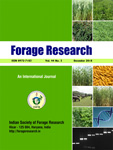K. S. AHLAWAT*, ANITA KUMARI, DALIP KUMAR, KAUTILYA CHAUDHARY, CHHAVI SIROHI, SATPAL, SANJAY KUMAR AND PAWAN KUMAR POONIA
Department of Forestry, Department of Botany & Plant Physiology, Department of Agricultural Economics, Department of Soil Science, Department of G&PB (Forage section)
CCS Haryana Agricultural University, Hisar-125004, India
Krishi Vigyan Kendra, Kaithal, CCS HAU, Hisar
*(e-mail : ahlawat19799@gmail.com)
(Received: 18 April 2025; Accepted: 4 June 2025)
SUMMARY
The present study was carried out to evaluate the performance of sorghum intercropped with 3 years and 4 months old willow based agroforestry system at a spacing of 3×3 m. During the study period, the growth observations of willow tree showed considerable increase in height (6.7-7.5 m), dbh (9.9-11.1 cm) and basal diameter (12.9-14.2 cm). The growth, physiological parameters, yield attributes and green fodder yield of sorghum were recorded during the experimentation. The physiological parameters (chlorophyll, photosynthesis, transpiration and stomatal conductance) of sorghum with willow plantation and in open varied highly significantly indicating the dense shade effect of trees on agricultural crops as available per cent light intensity was considerably low under willow plantation over control. The chlorophyll content was recorded higher in willow-based agroforestry system as compared to control. The plant height, stem diameter, leaf area, fresh leaf and stem weight, TSS and green fodder yield in sorghum showed highly significant variation in willow and open (control). The fodder yield varied from 8.09 (with willow) to 44.42 (control) t/ha. The per cent yield reduction in willow plantation was 81.79 %, respectively over control. The B: C ratio (0.21) in the above experiment was also negative in willow-based agroforestry system.
Key words: Agroforestry, willow, sorghum, green fodder yield, light intensity

